Analysis of Wildfire Danger Level Using Logistic Regression Model in Sichuan Province, China
Abstract
:1. Introduction
2. Materials and Methods
2.1. Study Region
2.2. Data and Preprocessing
2.2.1. Wildfire Spot Data Sources and Processing
2.2.2. Meteorological Data
2.2.3. NDVI Data and Vegetation Type
2.2.4. Topography, Road Network and Population
2.3. Analysis Methods
2.3.1. Factor Normalization Treatment
2.3.2. Multicollinearity Test of Model Input Variables
2.3.3. Identification of Significant Variables
2.3.4. Binary Logistic Regression Model
2.3.5. Model Training and Validation
3. Results
3.1. Temporal and Spatial Distribution Patterns of Fire Spots
3.2. Major Contributing Factors Identification
3.3. The Effects of Different Factors on Wildfire Occurrence
3.4. Model Prediction Accuracy
3.5. Probability of Fire Occurrence
4. Discussion
4.1. Confidence of Fire Spot Data
4.2. Spatiotemporal Variation Patterns of Wildfires in Sichuan Province
4.3. The Main Factors Responsible for Wildfire
4.4. Model Uncertainty
4.5. Limitations and Future Works
5. Conclusions
- (1)
- Annual fluctuations were not significantly related to the occurrence of wildfires in Sichuan Province, but significantly correlated with monthly change and geographical differences. Wildfire spots are displayed most frequently from December to the following June. They were mostly located in the western and southern part of Sichuan, in areas like Panzhihua City, Liangshan City, and Ganzi City.
- (2)
- Temperature, elevation, precipitation, population density, NDVI of last month, NDVI, and road density are the crucial factors influencing the occurrence of wildfires in Sichuan Province.
- (3)
- The LR regression model is more suitable in the analysis of the probability of wildfire occurrence in Sichuan Province, and the model accuracy is higher.
- (4)
- Based on the results of the prediction, wildfires are concentrated in the southwestern portion, in areas such as Panzhihua and Liangshan cities, which are critical for wildfire prevention due to their locations in the dry and hot river valley and their dry climate. Some central areas also have a high incidence of wildfire, such as Ganzi City, Yaan City and Leshan City, which are rich in forest resources, and should not be overlooked for wildfire prevention.
Author Contributions
Funding
Data Availability Statement
Conflicts of Interest
References
- Baker, A.G.; Catterall, C. Managing fire-dependent vegetation in Byron Shire, Australia: Are we restoring the keystone ecological process of fire? Ecol. Manag. Restor. 2016, 17, 47–55. [Google Scholar] [CrossRef]
- Dantas, V.D.L.; Batalha, M.A.; Pausas, J.G.; Inouye, B.D. Fire drives functional thresholds on the savanna-forest transition. Ecology 2013, 94, 2454–2463. [Google Scholar] [CrossRef] [PubMed]
- Krawchuk, M.A.; Moritz, M.A.; Yavitt, J.B. Constraints on global fire activity vary across a resource gradient. Ecology 2011, 92, 121–132. [Google Scholar] [CrossRef] [PubMed]
- Adab, H.; Kanniah, K.D.; Solaimani, K. Modeling forest fire risk in the northeast of Iran using remote sensing and GIS techniques. Nat. Hazards 2013, 65, 1723–1743. [Google Scholar] [CrossRef]
- Coogan, S.C.P.; Robinne, F.; Jain, P.; Flannigan, M.D. Scientists’ warning on wildfire—A Canadian perspective. Can. J. For. Res. 2019, 49, 1015–1023. [Google Scholar] [CrossRef]
- Zeng, N.; Mariotti, A.; Wetzel, P. Terrestrial mechanisms of interannual CO2 variability. Glob. Biogeochem. Cycles 2005, 19, GB1016. [Google Scholar] [CrossRef]
- Gonzalez, P.; Neilson, R.P.; Lenihan, J.M.; Drapek, R.J. Global patterns in the vulnerability of ecosystems to vegetation shifts due to climate change. Glob. Ecol. Biogeogr. 2010, 6, 768–775. [Google Scholar] [CrossRef]
- Yue, X.; Unger, N. Fire air pollution reduces global terrestrial productivity. Nat. Commun. 2018, 9, 5413. [Google Scholar] [CrossRef]
- Kelly, L.T.; Giljohann, K.M.; Duane, A.; Aquilué, N.; Archibald, S.; Batllori, E.; Bennett, A.F.; Buckland, S.T.; Canelles, Q.; Clarke, M.F.; et al. Fire and biodiversity in the Anthropocene. Science 2020, 370, eabb0355. [Google Scholar] [CrossRef]
- Hantson, S.; Arneth, A.; Harrison, S.; Yue, C. The status and challenge of global fire modelling. Biogeosci. Discuss. 2016, 11, 3359–3375. [Google Scholar] [CrossRef]
- Alló, M.; Loureiro, M.L. Assessing preferences for wildfire prevention policies in Spain. For. Policy Econ. 2020, 115, 102145. [Google Scholar] [CrossRef]
- Boer, M.M.; Resco De Dios, V.; Bradstock, R.A. Unprecedented burn area of Australian mega forest fires. Nat. Clim. Chang. 2020, 10, 171–172. [Google Scholar] [CrossRef]
- Ward, M.; Tulloch, A.I.T.; Radford, J.Q.; Williams, B.A.; Reside, A.E.; Macdonald, S.L.; Mayfield, H.J.; Maron, M.; Possingham, H.P.; Vine, S.J.; et al. Impact of 2019–2020 mega-fires on Australian fauna habitat. Nat. Ecol. Evol. 2020, 4, 1321–1326. [Google Scholar] [CrossRef] [PubMed]
- Brown, P.T.; Hanley, H.; Mahesh, A.; Reed, C.; Strenfel, S.J.; Davis, S.J.; Kochanski, A.K.; Clements, C.B. Climate warming increases extreme daily wildfire growth risk in California. Nature 2023, 621, 760–766. [Google Scholar] [CrossRef]
- Flannigan, M.D.; Krawchuk, M.A.; de Groot, W.J.; Wotton, B.M.; Gowman, L.M. Implications of changing climate for global wildland fire. Int. J. Wildland Fire 2009, 18, 483. [Google Scholar] [CrossRef]
- Moritz, M.A.; Batllori, E.; Bradstock, R.A.; Gill, A.M.; Handmer, J.; Hessburg, P.F.; Leonard, J.; McCaffrey, S.; Odion, D.C.; Schoennagel, T.; et al. Learning to coexist with wildfire. Nature 2014, 515, 58–66. [Google Scholar] [CrossRef]
- Doerr, S.H.; Santín, C. Global trends in wildfire and its impacts: Perceptions versus realities in a changing world. Philos. Trans. R. Soc. B Biol. Sci. 2016, 371, 20150345. [Google Scholar] [CrossRef]
- Hong, H.; Jaafari, A.; Zenner, E.K. Predicting spatial patterns of wildfire susceptibility in the Huichang County, China: An integrated model to analysis of landscape indicators. Ecol. Indic. 2019, 101, 878–891. [Google Scholar] [CrossRef]
- Bonan, D.B.; Siler, N.; Roe, G.H.; Armour, K.C. Energetic Constraints on the Pattern of Changes to the Hydrological Cycle under Global Warming. J. Clim. 2023, 36, 3499–3522. [Google Scholar] [CrossRef]
- Sauter, C.; Fowler, H.J.; Westra, S.; Ali, H.; Peleg, N.; White, C.J. Compound extreme hourly rainfall preconditioned by heatwaves most likely in the mid-latitudes. Weather. Clim. Extrem. 2023, 40, 100563. [Google Scholar] [CrossRef]
- Abatzoglou, J.T.; Williams, A.P.; Barbero, R. Global Emergence of Anthropogenic Climate Change in Fire Weather Indices. Geophys. Res. Lett. 2019, 46, 326–336. [Google Scholar] [CrossRef]
- Field, R.D.; van der Werf, G.R.; Fanin, T.; Fetzer, E.J.; Fuller, R.; Jethva, H.; Levy, R.; Livesey, N.J.; Luo, M.; Torres, O.; et al. Indonesian fire activity and smoke pollution in 2015 show persistent nonlinear sensitivity to El Niño-induced drought. Proc. Natl. Acad. Sci. USA 2016, 113, 9204–9209. [Google Scholar] [CrossRef] [PubMed]
- Mokhov, I.I.; Chernokulsky, A.V.; Shkolnik, I.M. Regional model assessments of fire risks under global climate changes. Dokl. Earth Sci. 2006, 411, 1485–1488. [Google Scholar] [CrossRef]
- Jolly, W.M.; Cochrane, M.A.; Freeborn, P.H.; Holden, Z.A.; Brown, T.J.; Williamson, G.J.; Bowman, D.M.J.S. Climate-induced variations in global wildfire danger from 1979 to 2013. Nat. Commun. 2015, 6, 7537. [Google Scholar] [CrossRef] [PubMed]
- Bowman, D.M.J.S.; Kolden, C.A.; Abatzoglou, J.T.; Johnston, F.H.; van der Werf, G.R.; Flannigan, M. Vegetation fires in the Anthropocene. Nat. Rev. Earth Environ. 2020, 1, 500–515. [Google Scholar] [CrossRef]
- Thorley, J.; Srivastava, S.K.; Shapcott, A. What type of rainforest burnt in the South East Queensland’s 2019/20 bushfires and how might this impact biodiversity. Austral Ecol. 2023, 48, 616–642. [Google Scholar] [CrossRef]
- Truong, T.X.; Nhu, V.; Phuong, D.T.N.; Nghi, L.T.; Hung, N.N.; Hoa, P.V.; Bui, D.T. A New Approach Based on TensorFlow Deep Neural Networks with ADAM Optimizer and GIS for Spatial Prediction of Forest Fire Danger in Tropical Areas. Remote Sens. 2023, 15, 3458. [Google Scholar] [CrossRef]
- Boyd, M.A.; Walker, X.J.; Barnes, J.; Celis, G.; Goetz, S.J.; Johnstone, J.F.; Link, N.T.; Melvin, A.M.; Saperstein, L.; Schuur, E.A.G.; et al. Decadal impacts of wildfire fuel reduction treatments on ecosystem characteristics and fire behavior in alaskan boreal forests. For. Ecol. Manag. 2023, 546, 121347. [Google Scholar] [CrossRef]
- Han, H.; Yin, Y.; Zhao, Y.; Qin, F. Spatiotemporal Variations in Fractional Vegetation Cover and Their Responses to Climatic Changes on the Qinghai–Tibet Plateau. Remote Sens. 2023, 15, 2662. [Google Scholar] [CrossRef]
- Davies, G.M.; Gray, A.; Power, S.C.; Domènech, R. Resilience of temperate peatland vegetation communities to wildfire depends upon burn severity and pre-fire species composition. Ecol. Evol. 2023, 13, e9912. [Google Scholar] [CrossRef]
- Shi, K.; Touge, Y. Identifying the shift in global wildfire weather conditions over the past four decades: An analysis based on change-points and long-term trends. Geosci. Lett. 2023, 10, 3. [Google Scholar] [CrossRef]
- Zheng, B.; Ciais, P.; Chevallier, F.; Chuvieco, E.; Chen, Y.; Yang, H. Increasing forest fire emissions despite the decline in global burned area. Sci. Adv. 2021, 7, eabh2646. [Google Scholar] [CrossRef] [PubMed]
- Pérez-Invernón, F.J.; Gordillo-Vázquez, F.J.; Huntrieser, H.; Jöckel, P. Variation of lightning-ignited wildfire patterns under climate change. Nat. Commun. 2023, 14, 739. [Google Scholar] [CrossRef]
- Řehoř, J.; Brázdil, R.; Trnka, M.; Balek, J. Flash droughts in Central Europe and their circulation drivers. Clim. Dynam 2023, 1–15. [Google Scholar] [CrossRef]
- Wan, C.; Roy, S.S. Geospatial characteristics of fire occurrences in southern hemispheric Africa and Madagascar during 2001–2020. J. For. Res. 2023, 34, 553–563. [Google Scholar] [CrossRef]
- Costa, R.; Baker, J.W. A methodology to estimate postdisaster unmet housing needs using limited data: Application to the 2017 California wildfires. Risk Anal. 2023, 1–18. [Google Scholar] [CrossRef] [PubMed]
- Davis, R.E.; Roney, P.C.; Pane, M.M.; Johnson, M.C.; Leigh, H.V.; Basener, W.; Curran, A.L.; DeMarcy, B.; Jang, J.; Schroeder, C.; et al. Climate and human mortality in Virginia, 2005–2020. Sci. Total Environ. 2023, 894, 164825. [Google Scholar] [CrossRef]
- Jerin, T.; Chowdhury, M.A.; Azad, M.A.K.; Zaman, S.; Mahmood, S.; Islam, S.L.U.; Mohammad Jobayer, H. Extreme weather events (EWEs)-Related health complications in Bangladesh: A gender-based analysis on the 2017 catastrophic floods. Nat. Hazards Res. 2023. [Google Scholar] [CrossRef]
- Zhu, Z.; Zhao, F.; Wang, Q.H.; Gao, Z.L.; Deng, X.F.; Huang, P.G. Driving factors of forest fire and fire risk zoning in Kunming City. J. Zhejiang A&F Univ. 2022, 39, 380–387. [Google Scholar]
- Zhu, Z.; Zhao, F.; Wang, Q.H.; Deng, X.F.; Gao, Z.L. Research Progress in Forest Fire Occurrence Prediction Models. World For. Res. 2022, 35, 6. [Google Scholar]
- Deng, O.; Li, Y.Q.; Feng, Z.K.; Zhang, D.Y. Model and zoning of forest fire risk in Heilongjiang province based on spatial Logistic. Trans. Chin. Soc. Agric. Eng. 2012, 28, 7. [Google Scholar]
- Su, Z.W.; Liu, A.; Guo, F.T.; Liang, H.L.; Wang, W.H.; Lin, F.F. Driving factors and spatial distribution patteren of forest fire in Fujian Province. J. Nat. Disasters 2016, 25, 10. [Google Scholar]
- Ma, W.Y.; Feng, Z.K.; Cheng, Z.X.; Wang, F.G. Study on driving factors and distribution pattern of forest fires in Shanxi province. J. Cent. South. Univ. For. Technol. 2020, 40, 57–69. [Google Scholar]
- Wang, W.G.; Pan, J.H.; Feng, Y.Y.; Li, Z.; Dong, L.L. Model and Zoning of Fire Risk in GansuProvince based on GWLR and MODIS Imagery. Remote Sens. Technol. Appl. 2017, 32, 514–523. [Google Scholar]
- Gao, B.; Chen, X.; Shan, Z.H.; Han, X.Y.; Shan, Y.L.; Yin, S.N.; Yu, B. Prediction of forest fire probability in Daxing’an Mountains area based on Logistic regression model. J. Saf. Sci. Technol. 2022, 18, 163–168. [Google Scholar]
- Guo, F.T.; Wang, G.Y.; Su, Z.W.; Liang, H.L.; Wang, W.H.; Lin, F.; Liu, A. What drives forest fire in Fujian, China? Evidence from logistic regression and Random Forests. Int. J. Wildland Fire 2016, 25, 505. [Google Scholar] [CrossRef]
- Wang, Z.H.; Dong, H.; Zhao, Y.Y.; He, S.C.; Yuan, Y.B.; Zhang, L.W. Prediction of Forest Fire Risk in Yunnan, Guizhou and Sichuan Using Machine Learning Model. J. Northeast. For. Univ. 2023, 51, 113–119. [Google Scholar]
- Zhu, X.; Li, J.W.; Guo, W.; Bi, S.; Wu, Y.F. Forest fire risk prediction model based on machine learning. China Saf. Sci. J. 2022, 32, 152–157. [Google Scholar]
- Wang, J.H.; Long, X.H.; Li, D.; Niu, S.K. Spatial Distribution of Forest Fires in Sichuan Province Based on GIS. J. Northeast. For. Univ. 2012, 40, 51–56. [Google Scholar]
- Tian, X.R.; Zhao, F.J.; Shu, L.F.; Wang, M.Y. Hotspots from Satellite Monitoring and Forest Fire Weather Index Analysis for Southwest China. For. Res. 2010, 23, 7. [Google Scholar]
- Wang, X.; Wang, R.T. Temporal and Spatial Characteristics of Forest Fire in Sichuan and Its Climate Background. Chin. Agric. Sci. Bull. 2014, 30, 155–160. [Google Scholar]
- Zhang, X.Y.; Su, X.H. Correlation Analysis on Forest Fire Occurring Frequency and Meteorological Factors in Sichuan. J. Northwest For. Univ. 2017, 32, 176–180. [Google Scholar]
- Li, D.; Niu, S.K.; Long, X.H.; Xu, G.X.; Wang, S.; Chen, F. Relationship of forest fires and meteorological factors in Sichuan province. J. Northwest A&F Univ. (Nat. Sci. Ed.) 2013, 41, 67–74. [Google Scholar]
- Li, B.; Zhou, J.; Bu, J.W.; Jin, X.B.; Cheng, X.; Pan, B.; Feng, J.D. Analysis of Forest Fire Causes and Application of Lightning Monitoring Data in Muli County. J. Catastrophol. 2021, 36, 125–130. [Google Scholar]
- Bai, Y.; Wang, B.; Wu, Y.D.; Liu, B. Fire Environment of Forest Fire Formation in Liangshan Prefecture. For. Resour. Manag. 2020, 49, 116–122. [Google Scholar]
- Liu, J.; Guo, H.Y.; Gan, W.W.; Xu, R.X.; Sun, R.; Li, Z.S.; Wang, C.X.; Luo, Y. Study on Spatio-Temporal Distribution and Heterogeneity of Climate Forces of Wildfires in Panxi Region. J. Southwest For. Univ. (Nat. Sci.) 2023, 43, 1–12. [Google Scholar]
- Wang, S.; Li, H.; Niu, S. Empirical Research on Climate Warming Risks for Forest Fires: A Case Study of Grade I Forest Fire Danger Zone, Sichuan Province, China. Sustainability 2021, 13, 7773. [Google Scholar] [CrossRef]
- Chas-Amil, M.L.; Prestemon, J.P.; McClean, C.J.; Touza, J. Human-ignited wildfire patterns and responses to policy shifts. Appl. Geogr. 2015, 56, 164–176. [Google Scholar] [CrossRef]
- Chen, D.C.; Li, W.P.; Cai, X.Y.; Jing, N.; Wang, R.F.; Tang, M.D.; Gao, Y.L. Analysis on the dynamic changes and their influencing factors of forest resources in Sichuan Province. J. Earth Environ. 2021, 12, 425–435. [Google Scholar]
- Guo, J.; Zhang, Y.; Zhao, W.; He, Q. Study of forest fire monitoring based on VIRR data from Fengyun-3C satellite. For. Fire Prev. 2015, 45–48. [Google Scholar] [CrossRef]
- Yang, J.; Dong, C.H. A New Generation of Fengyun Polar Orbiting Meteorological Satellite Business Products and Applications; Science Press: Beijing, China, 2011; p. 198. [Google Scholar]
- Catry, F.X.; Rego, F.C.; Bação, F.L.; Moreira, F. Modeling and mapping wildfire ignition risk in Portugal. Int. J. Wildland Fire 2009, 18, 921–931. [Google Scholar] [CrossRef]
- Gong, H.; Zhang, M.; Xiang, X.; Liu, H. 1 km monthly precipitation and temperatures dataset for China from 1952 to 2019 based on new baseline climatology surfaces. Sci. Total Environ. 2022, 906, 167613. [Google Scholar] [CrossRef] [PubMed]
- Shouzhang, P. 1-km monthly mean temperature dataset for china (1901–2021). In A Big Earth Data Platform for Three Poles; Northwest Institute of Eco-Environment and Resources: Lanzhou, China, 2019. [Google Scholar]
- Shouzhang, P. 1-km monthly precipitation dataset for China (1901–2021). In A Big Earth Data Platform for Three Poles; Northwest Institute of Eco-Environment and Resources: Lanzhou, China, 2020. [Google Scholar]
- Peng, S.; Gang, C.; Cao, Y.; Chen, Y. Assessment of climate change trends over the Loess Plateau in China from 1901 to 2100. Int. J. Clim. 2018, 38, 2250–2264. [Google Scholar] [CrossRef]
- Peng, S.; Ding, Y.; Wen, Z.; Chen, Y.; Cao, Y.; Ren, J. Spatiotemporal change and trend analysis of potential evapotranspiration over the Loess Plateau of China during 2011–2100. Agric. For. Meteorol. 2017, 233, 183–194. [Google Scholar] [CrossRef]
- Ding, Y.; Peng, S. Spatiotemporal Trends and Attribution of Drought across China from 1901–2100. Sustainability 2020, 12, 477. [Google Scholar] [CrossRef]
- Xu, M.C.; Ma, W.T. Relationship between Arid Climatic Factors and Forest Fires. J. Glaciol. Geocryol. 2012, 34, 603–608. [Google Scholar]
- Zhang, Y.L.; Guo, Y.; Hu, H.Q. Characteristics of Forest Fire Data in Southwest China during 2001–2017. J. Northwest For. Univ. 2021, 36, 179–186. [Google Scholar]
- Ye, Q.; Feng, W.Z.; Jiao, G.Y.; Deng, W.P. Drought characteristics and their impacts on vegetation net primary productivity in the subtropical China. Front. Ecol. Evol. 2023, 11, 1181332. [Google Scholar] [CrossRef]
- Dormann, C.F.; Elith, J.; Bacher, S.; Buchmann, C.; Carl, G.; Carré, G.; Marquéz, J.R.G.; Gruber, B.; Lafourcade, B.; Leitão, P.J. Collinearity: A review of methods to deal with it and a simulation study evaluating their performance. Ecography 2013, 36, 27–46. [Google Scholar] [CrossRef]
- Jin, T.; Hu, X.; Liu, B.; Xi, C.; He, K.; Cao, X.; Luo, G.; Han, M.; Ma, G.; Yang, Y. Susceptibility Prediction of Post-Fire Debris Flows in Xichang, China, Using a Logistic Regression Model from a Spatiotemporal Perspective. Remote Sens. 2022, 14, 1306. [Google Scholar] [CrossRef]
- Breiman, L. Random Forests. Mach. Learn. 2001, 45, 5–32. [Google Scholar] [CrossRef]
- Schaefer, J.T. The Critical Success Index as an Indicator of Warning Skill. Weather. Forecast. 1990, 5, 570–575. [Google Scholar] [CrossRef]
- Rodrigues, M.; De, L.; Fotheringham, S. Modeling the spatial variation of the explanatory factors of human-caused wildfires in Spain using geographically weighted logistic regression. Appl. Geogr. 2014, 48, 52–63. [Google Scholar] [CrossRef]
- Earl, N.; Simmonds, I. Spatial and Temporal Variability and Trends in 2001–2016 Global Fire Activity. J. Geophys. Res. Atmos. 2018, 123, 2524–2536. [Google Scholar] [CrossRef]
- Ren, J.; Shen, C.M.; Liu, F.; Ye, L.Y. Temporal and spatial dynamics of MODIS fire points in Xishuangbanna, Yunnan during 2011 to 2020. Chin. J. Ecol. 2023, 42, 1953–1962. [Google Scholar]
- Zeng, A.C.; Guo, X.S.; Zheng, W.X.; Wei, M.; Jin, Q.F.; Guo, F.T. Temporal and spatial dynamic characteristics of forest fire in Zhejiang Province of eastern China based on MODIS satellite hot spot data. J. Beijing For. Univ. 2020, 42, 39–46. [Google Scholar]
- Alizadeh, M.R.; Abatzoglou, J.T.; Luce, C.H.; Adamowski, J.F.; Farid, A.; Sadegh, M. Warming enabled upslope advance in western US forest fires. Proc. Natl. Acad. Sci. USA 2021, 118, e2009717118. [Google Scholar] [CrossRef]
- Serbouti, S.; Abbas, Y.; Ettaqy, A.; Boukcim, H.; Achiban, H.; Abderrazzak, B.; Ghachtouli, N.E. Evolution of wildfires, burned areas, and affected species in Middle Atlas forests (Morocco) from 2000 to 2020. Trees For. People 2022, 10, 100319. [Google Scholar] [CrossRef]
- Carmo, M.; Moreira, F.; Casimiro, P.; Vaz, P. Land use and topography influences on wildfire occurrence in northern Portugal. Landsc. Urban. Plan. 2011, 100, 169–176. [Google Scholar] [CrossRef]
- Wastl, C.; Schunk, C.; Lüpke, M.; Cocca, G.; Conedera, M.; Valese, E.; Menzel, A. Large-scale weather types, forest fire danger, and wildfire occurrence in the Alps. Agric. For. Meteorol. 2013, 168, 15–25. [Google Scholar] [CrossRef]
- Heyerdahl Emily, K.; Brubaker Linda, B.; Agee James, K. Spatial controls of historical fire regimes: A multiscale example from the interior west, USA. Ecology 2001, 82, 660–678. [Google Scholar] [CrossRef]
- Rogeau, M.; Armstrong, G.W. Quantifying the effect of elevation and aspect on fire return intervals in the Canadian Rocky Mountains. For. Ecol. Manag. 2017, 384, 248–261. [Google Scholar] [CrossRef]
- Li, X.W.; Zhao, G.; Yu, X.B.; Yu, Q. Probability models of forest fire risk based on ecology factors in different vegetation regions over China. Acta Ecol. Sin. 2013, 33, 1219–1229. [Google Scholar]
- Brosofske, K.D.; Cleland, D.T.; Saunders, S.C. Factors Influencing Modern Wildfire Occurrence in the Mark Twain National Forest, Missouri. South. J. Appl. For. 2007, 31, 73–84. [Google Scholar] [CrossRef]
- Stephens, S.L. Forest fire causes and extent on United States Forest Service lands. Int. J. Wildland Fire 2005, 14, 213. [Google Scholar] [CrossRef]
- Hu, T.; Zhou, G. Drivers of lightning- and human-caused fire regimes in the Great Xing’an Mountains. For. Ecol. Manag. 2014, 329, 49–58. [Google Scholar] [CrossRef]
- Wang, H.; Jin, B.; Zhang, K.; Aktar, S.; Song, Z. Effectiveness in Mitigating Forest Fire Ignition Sources: A Statistical Study Based on Fire Occurrence Data in China. Fire 2022, 5, 215. [Google Scholar] [CrossRef]
- Weise, D.R.; Wright, C.S. Wildland fire emissions, carbon and climate: Characterizing wildland fuels. For. Ecol. Manag. 2014, 317, 26–40. [Google Scholar] [CrossRef]
- Zacharakis, I.; Tsihrintzis, V.A. Integrated wildfire danger models and factors: A review. Sci. Total Environ. 2023, 899, 165704. [Google Scholar] [CrossRef]
- Gaboriau, D.M.; Chaste, É.; Girardin, M.P.; Asselin, H.; Ali, A.A.; Bergeron, Y.; Hély, C. Interactions within the climate-vegetation-fire nexus may transform 21st century boreal forests in northwestern Canada. Iscience 2023, 26, 106807. [Google Scholar] [CrossRef]
- Syphard, A.D.; Keeley, J.E. Location, timing and extent of wildfire vary by cause of ignition. Int. J. Wildland Fire 2015, 24, 37. [Google Scholar] [CrossRef]
- Calviño-Cancela, M.; Chas-Amil, M.L.; García-Martínez, E.D.; Touza, J. Interacting effects of topography, vegetation, human activities and wildland-urban interfaces on wildfire ignition risk. For. Ecol. Manag. 2017, 397, 10–17. [Google Scholar] [CrossRef]
- Spiecker, H.; Kahle, H.P. Climate-driven tree growth and mortality in the Black Forest, Germany—Long-term observations. Glob. Chang. Biol. 2023, 29, 5908–5923. [Google Scholar] [CrossRef] [PubMed]
- Rodrigues, M.; Cunill Camprubí, À.; Balaguer-Romano, R.; Coco Megía, C.J.; Castañares, F.; Ruffault, J.; Fernandes, P.M.; Resco De Dios, V. Drivers and implications of the extreme 2022 wildfire season in Southwest Europe. Sci. Total Environ. 2023, 859, 160320. [Google Scholar] [CrossRef] [PubMed]
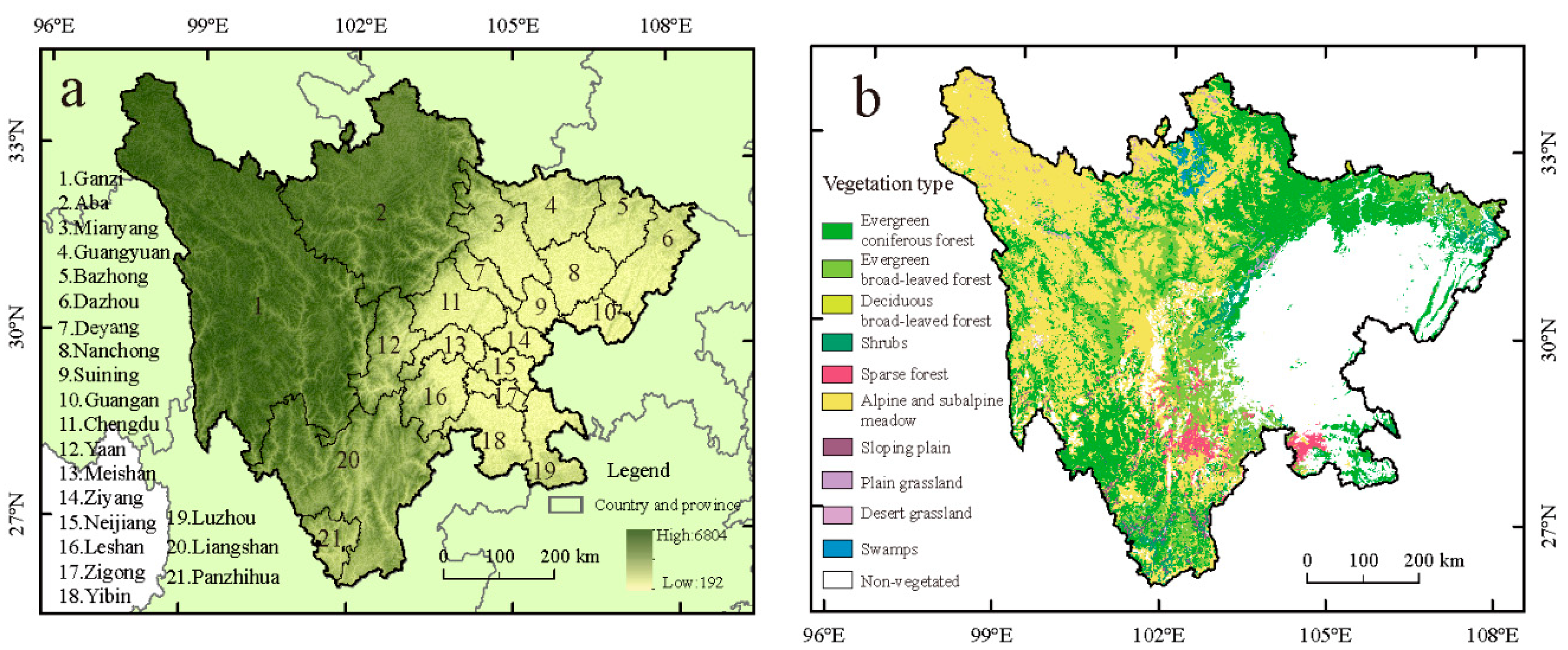
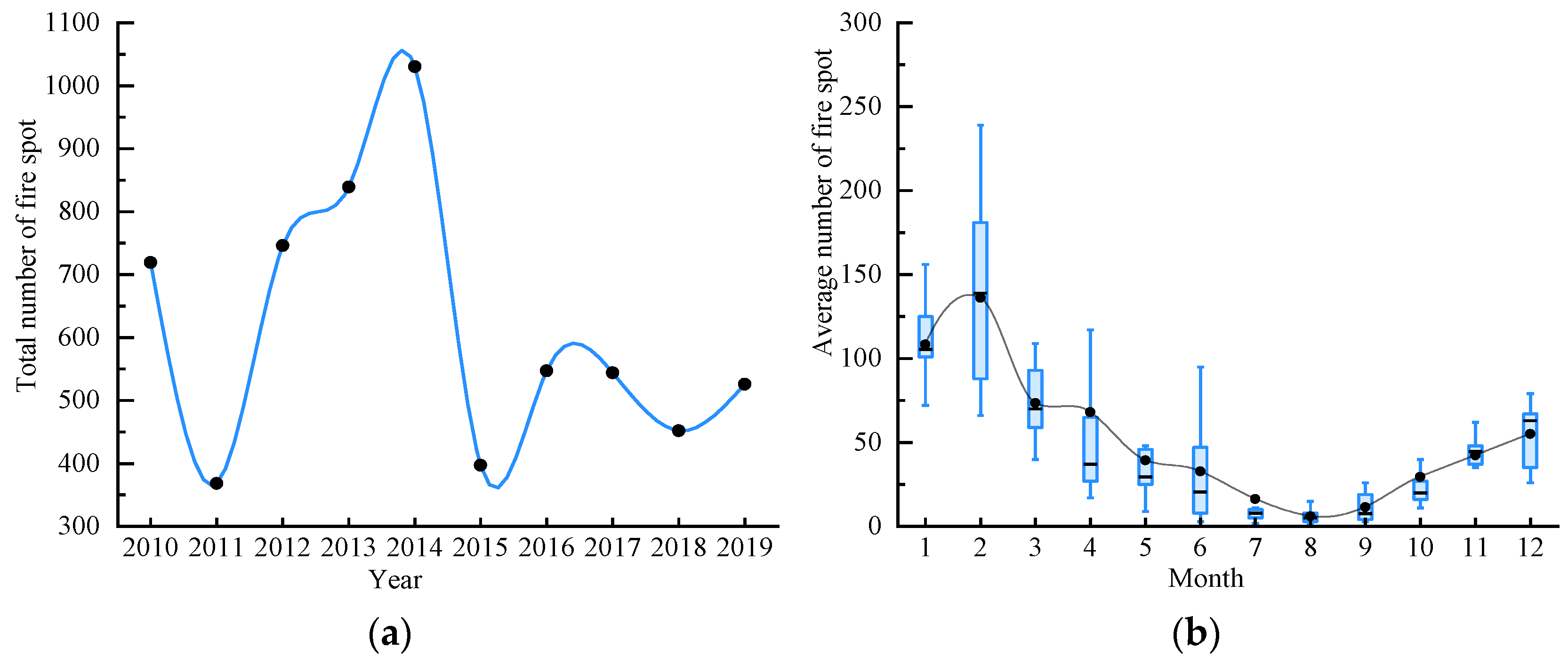

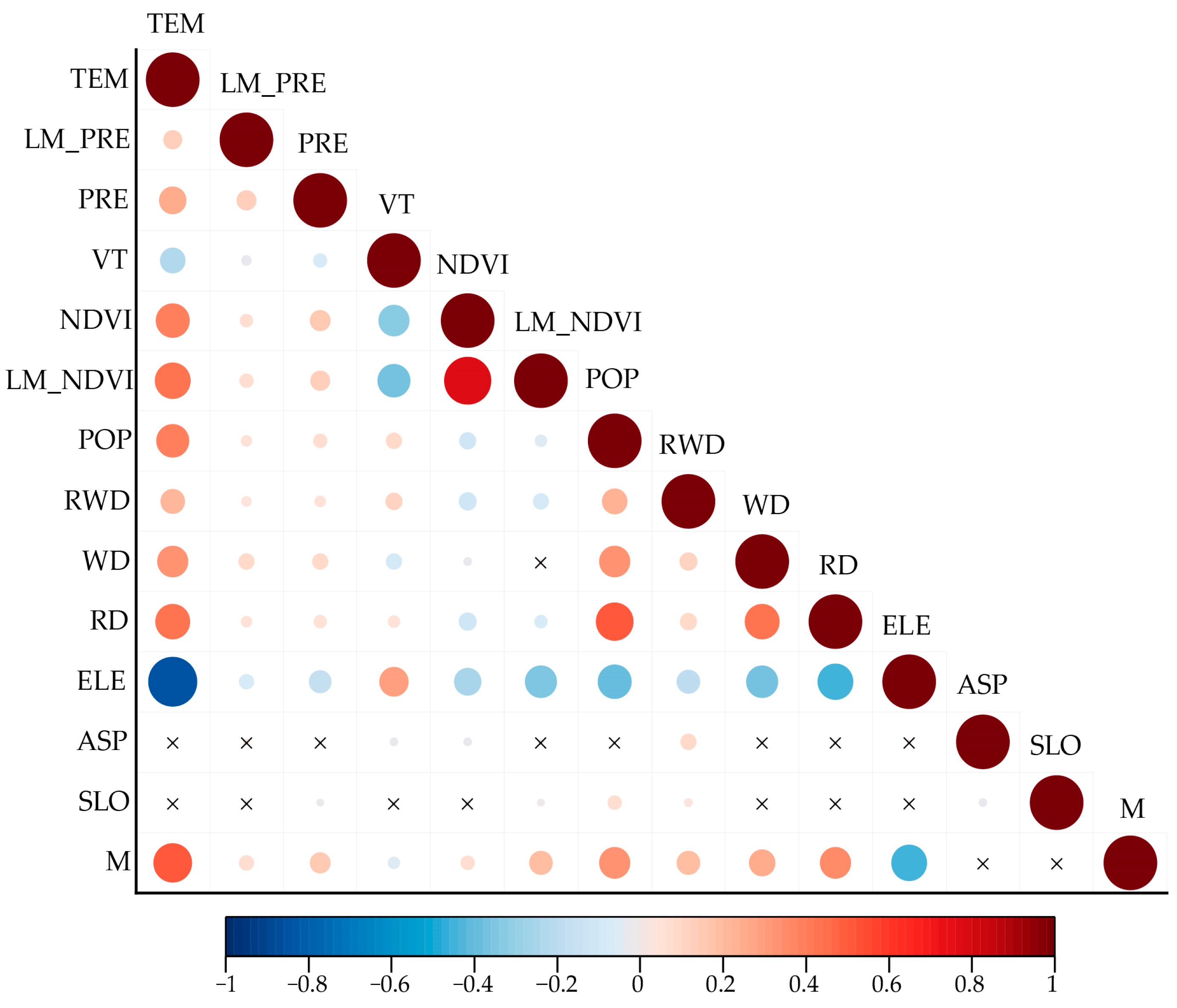
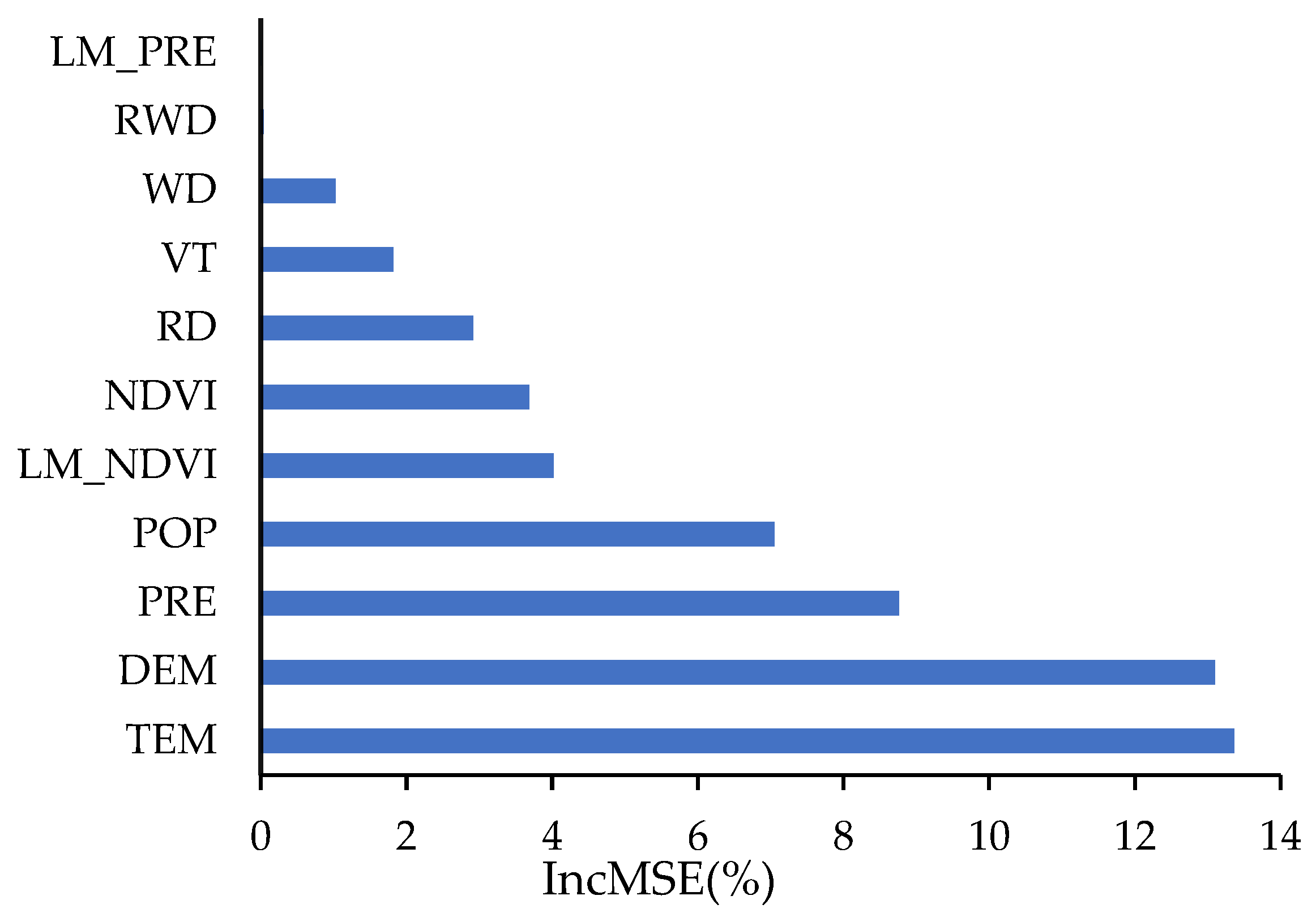
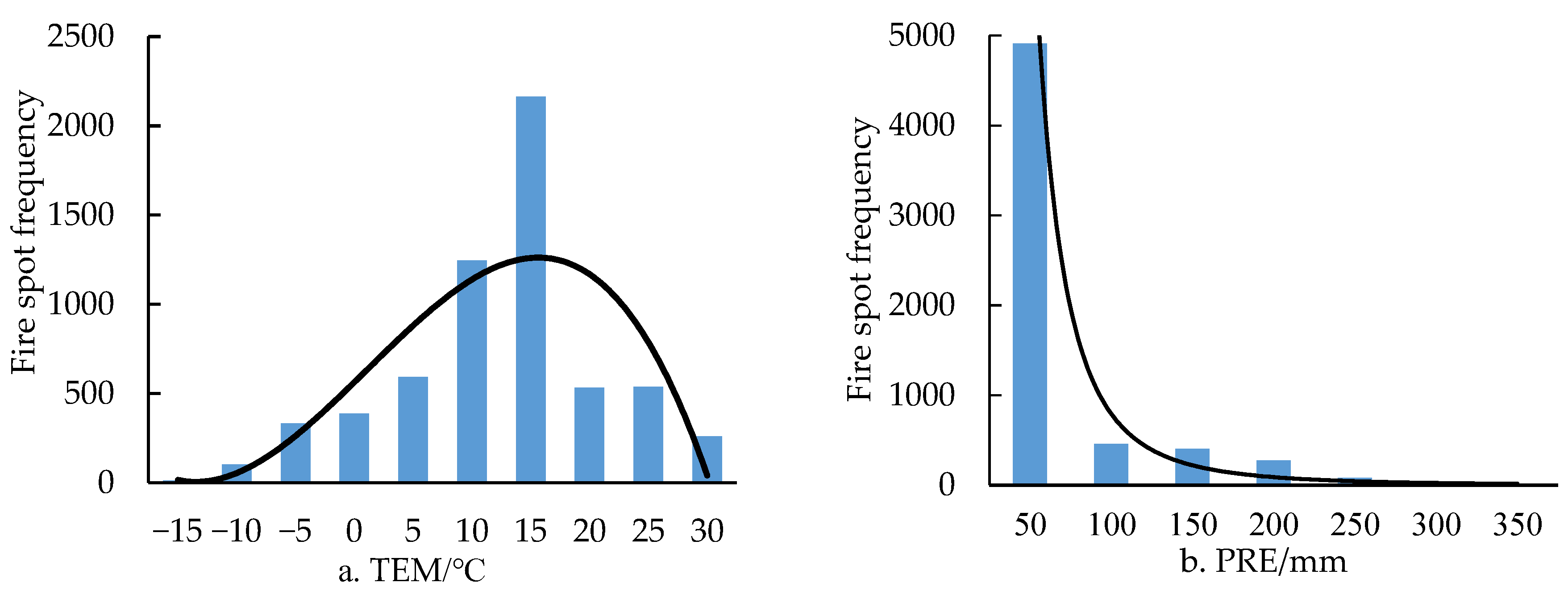
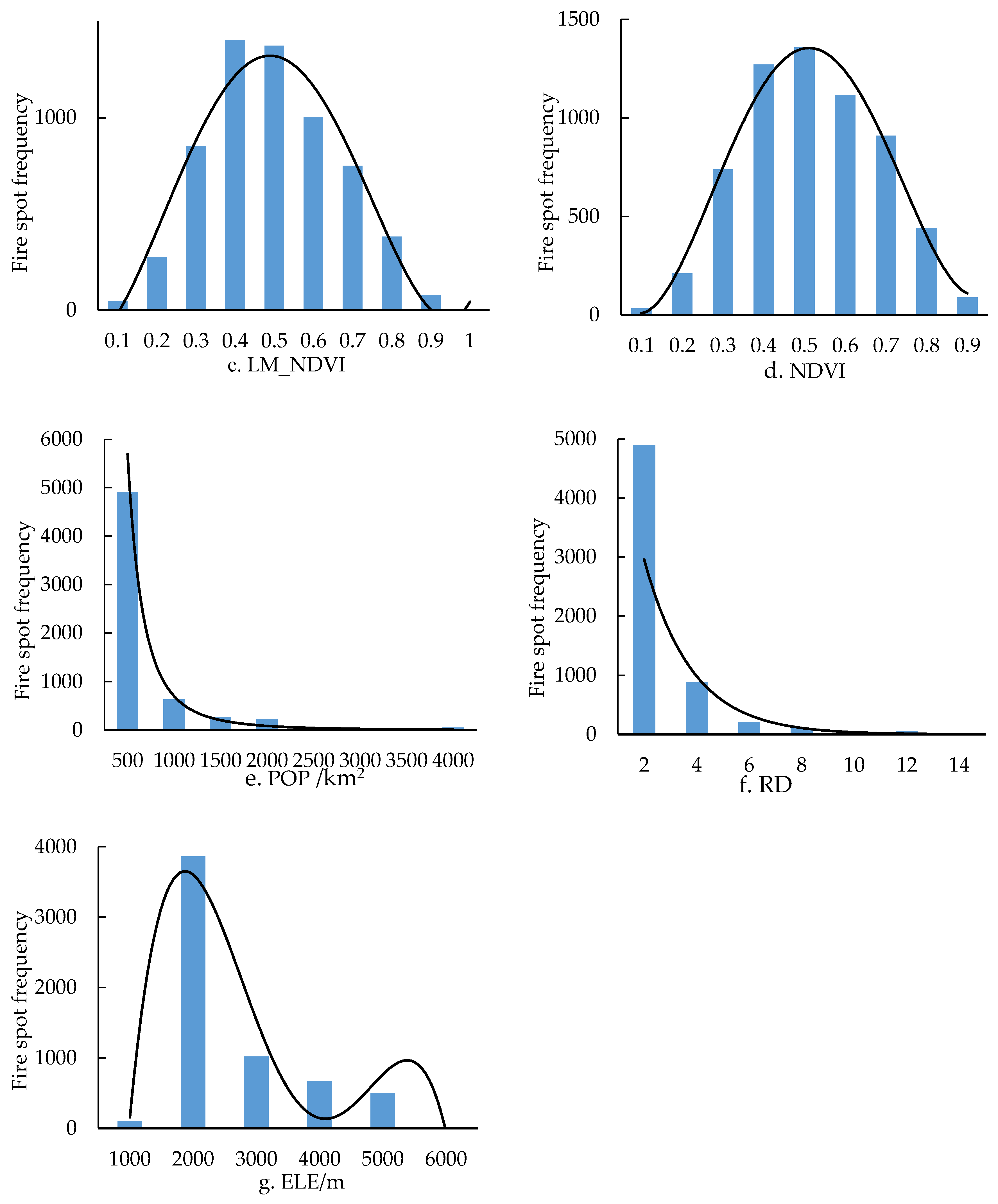
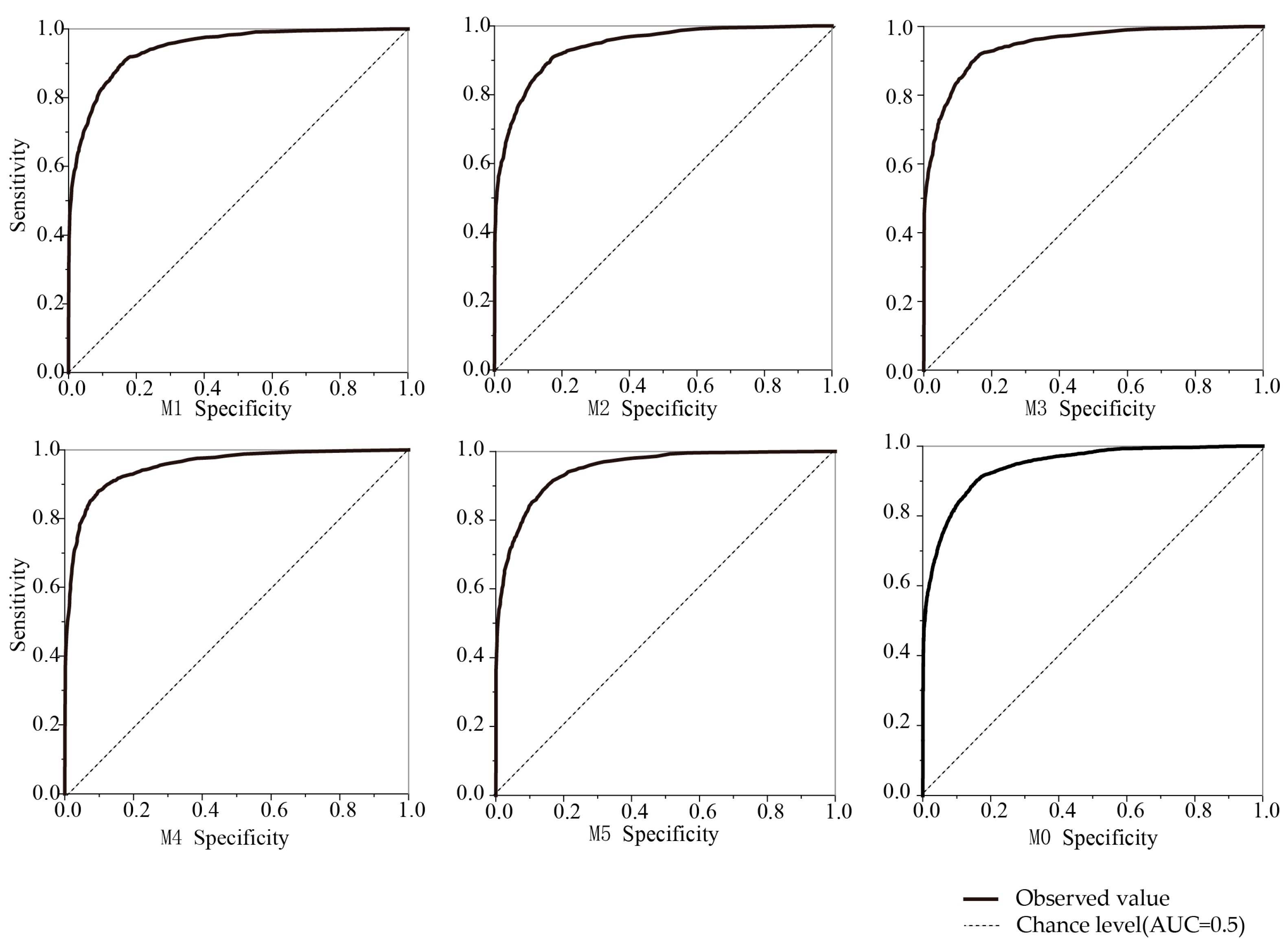
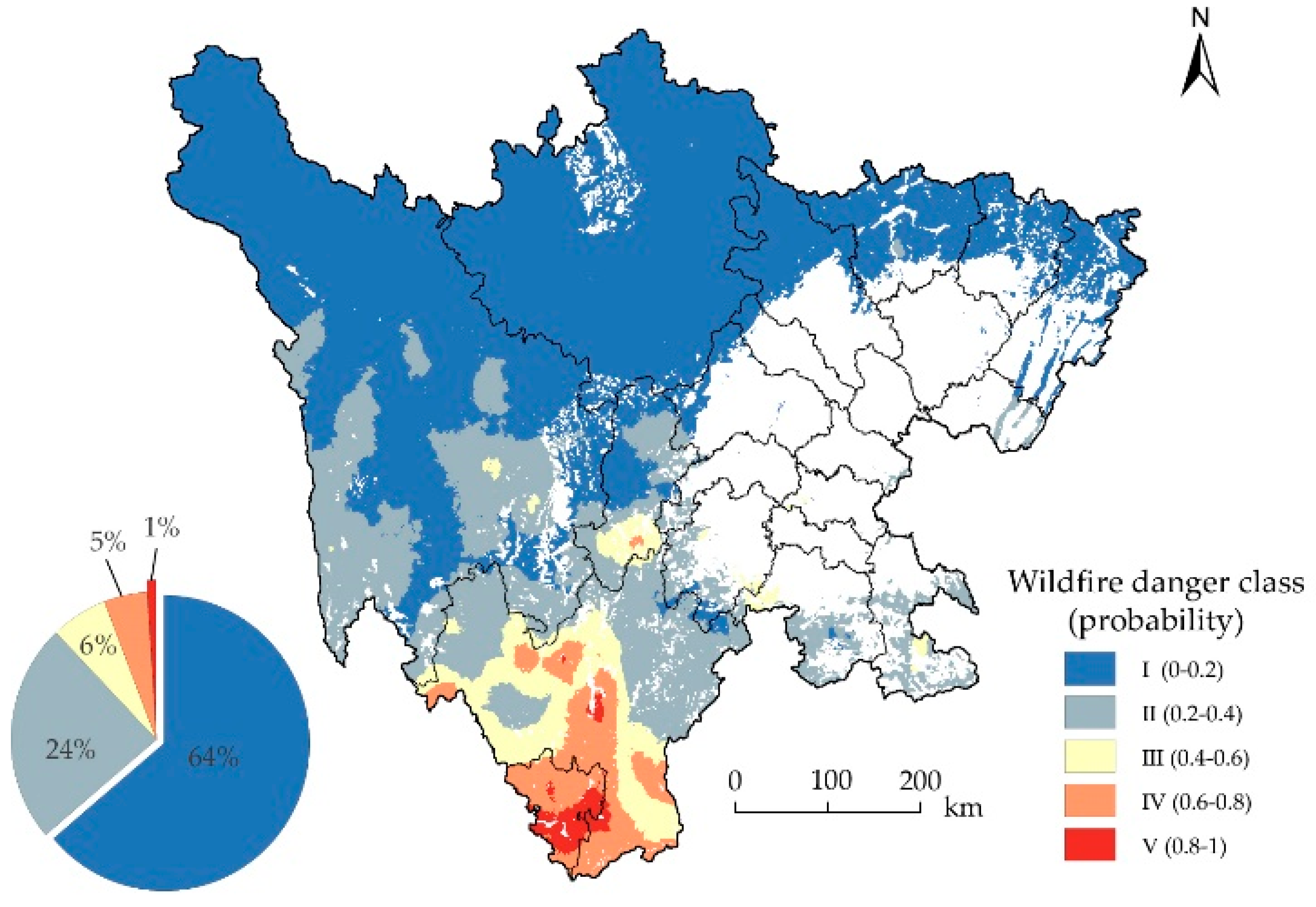
| Factor Type | Full Name | Symbol | Spatial Resolution | Format | Unit | Source | References |
|---|---|---|---|---|---|---|---|
| Meteorological factors | Monthly precipitation | PRE | 1 km | Continuous | mm | National Tibetan Plateau Data Center. (https://doi.org/10.5281/zenodo.3185722, accessed on 15 September 2023) | |
| Monthly precipitation for the last month | LM_PRE | 1 km | Continuous | mm | |||
| Monthly average temperature | TEM | 1 km | Continuous | °C | |||
| Monthly average temperature for the last month | LM_TEM | 1 km | Continuous | °C | |||
| Vegetation factors | Vegetation type | VT | 1 km | Categorical | -- | Resource and EnvironmentScience and Data Center (http://www.resdc.cn, accessed on 15 September 2023) | Guo et al. (2016) [46] |
| Normalized Difference Vegetation Index | NDVI | 1 km | Continuous | % | 16-day synthetic product dataset for MOD13A2(https://www.gscloud.cn/home#page1/2, accessed on 15 September 2023) | Wang et al. (2017) [44] | |
| Normalized Difference Vegetation Index for the last month | LM_NDVI | 1 km | Continuous | % | |||
| Topographic factors | Elevation | ELE | 30 m | Continuous | m | Geospatial Data Cloud (https://www.gscloud.cn/, accessed on 15 September 2023) | Gao et al. (2022) [45]; Guo et al. (2016) [46] |
| Slope | SLO | 30 m | Continuous | angles | |||
| Aspect | ASP | 30 m | Categorical | -- | |||
| Waterways kernel density | WD | Bandwidths 1 km | Continuous | -- | http://download.geofabrik.de/index.html (accessed on 15 September 2023) | ||
| Road Network | Road kernel density | RD | Bandwidths 1 km | Continuous | -- | http://download.geofabrik.de/index.html (accessed on 15 September 2023) | |
| Railway kernel density | RWD | Bandwidths 1 km | Continuous | -- | |||
| Population | Population density | POP | 1 km | Continuous | number/km | https://hub.worldpop.org/project/categories?id=3 (accessed on 15 September 2023) | Guo et al. (2016) [46] |
| Aspect | Azimuth |
|---|---|
| Shady slope | 337.5°~360.0° |
| Semi-shady slope | 67.5°~112.5°, 292.5°~337.5° |
| Sunny slope | 157.5°~247.5° |
| Semi-sunny slope | 112.5°~157.5°, 247.5°~292.5° |
| Observed | |||
|---|---|---|---|
| Fire Spot Data | No Fire Spot Data | ||
| Predicted | fire spot data | TP | FP |
| no fire spot data | FN | TN | |
| The Probability of a Wildfire | Fire Danger | Danger Level |
|---|---|---|
| 0~0.2 | I | Extreme low danger |
| 0.2~0.4 | II | Low danger |
| 0.4~0.6 | III | Medium danger |
| 0.6~0.8 | IV | High danger |
| 0.8~1 | V | Extreme high danger |
| Factor | VIF Value (All Factors) | VIF Value (Removing LM_TEM) |
|---|---|---|
| LM_TEM | 6.316 | --- |
| TEM | 5.549 | 3.933 |
| LM_PRE | 1.036 | 1.034 |
| PRE | 1.102 | 1.093 |
| ELE | 4.460 | 3.807 |
| ASP | 1.012 | 1.012 |
| SLO | 1.009 | 1.009 |
| VT | 1.285 | 1.272 |
| LM_NDVI | 2.885 | 2.883 |
| NDVI | 2.854 | 2.630 |
| POP | 1.537 | 1.533 |
| RWD | 1.154 | 1.143 |
| RD | 1.736 | 1.717 |
| WD | 1.318 | 1.317 |
| AUC | ACC (%) | TPR | TS | |
|---|---|---|---|---|
| M1 | 0.944 | 87.25 | 0.824 | 0.718 |
| M2 | 0.941 | 86.81 | 0.828 | 0.713 |
| M3 | 0.945 | 87.55 | 0.830 | 0.734 |
| M4 | 0.953 | 89.36 | 0.861 | 0.762 |
| M5 | 0.949 | 87.59 | 0.830 | 0.721 |
| M0 | 0.944 | 87.28 | 0.829 | 0.723 |
Disclaimer/Publisher’s Note: The statements, opinions and data contained in all publications are solely those of the individual author(s) and contributor(s) and not of MDPI and/or the editor(s). MDPI and/or the editor(s) disclaim responsibility for any injury to people or property resulting from any ideas, methods, instructions or products referred to in the content. |
© 2023 by the authors. Licensee MDPI, Basel, Switzerland. This article is an open access article distributed under the terms and conditions of the Creative Commons Attribution (CC BY) license (https://creativecommons.org/licenses/by/4.0/).
Share and Cite
Peng, W.; Wei, Y.; Chen, G.; Lu, G.; Ye, Q.; Ding, R.; Hu, P.; Cheng, Z. Analysis of Wildfire Danger Level Using Logistic Regression Model in Sichuan Province, China. Forests 2023, 14, 2352. https://doi.org/10.3390/f14122352
Peng W, Wei Y, Chen G, Lu G, Ye Q, Ding R, Hu P, Cheng Z. Analysis of Wildfire Danger Level Using Logistic Regression Model in Sichuan Province, China. Forests. 2023; 14(12):2352. https://doi.org/10.3390/f14122352
Chicago/Turabian StylePeng, Wanyu, Yugui Wei, Guangsheng Chen, Guofan Lu, Qing Ye, Runping Ding, Peng Hu, and Zhenyu Cheng. 2023. "Analysis of Wildfire Danger Level Using Logistic Regression Model in Sichuan Province, China" Forests 14, no. 12: 2352. https://doi.org/10.3390/f14122352





